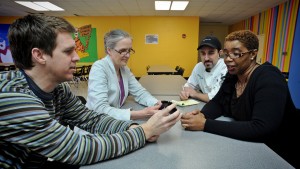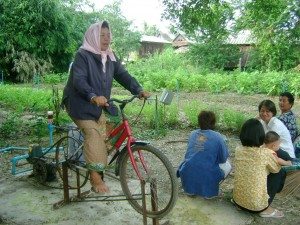Preventing chronic, obesity-related diseases
May 16, 2012
Eating right for better health is a good idea based on good science.
We have good evidence that eating fruits and vegetables, watching weight and treating diabetes are critical to good health. Those data are changing policies and practices worldwide.
Alice Ammerman
Motivating children and teens to eat healthful foods

Dr. Alice Ammerman, second from left, meets with David Cavallo, nutrition doctoral student, and Chapel Hill High School kitchen staff to discuss the pilot project ‘Taste Texting.’
Do children’s diets improve when parents provide locally grown fruits and vegetables? The Child Health Assessment and Monitoring Program (CHAMP) survey measures children’s health behaviors. Dr. Alice Ammerman, director of the UNC Center for Health Promotion and Disease Prevention, found that 50 percent of children surveyed ate five or more nutritious food servings when supplied by nearby producers.
Can we motivate high-school students’ wise food decisions in a chaotic cafeteria? Yes, Ammerman says–by having them precommit to healthy food choices via text on a Web-based system. Read more at tinyurl.com/text-your-lunch-order.
Myles Faith
Offering hope in treating childhood obesity
Dr. Myles Faith, associate professor of nutrition, studies familial influences on childhood obesity and prevention and treatment strategies. When he chaired an American Heart Association committee, parents and adult caregivers were identified as “agents of change” for obese children.
“Health professionals help children grow into healthier body weights by adopting good nutrition, physical activity and lifestyle habits,” he says. “Measurable goals, self-monitoring in writing, and daily routines to reinforce behavior changes motivate. The body of research on familybased interventions for childhood obesity offers hope to families.”
Ed Fisher
Peers for Progress – management of diabetes improves outcomes
“Diabetes self-management is essential to reducing risks of associated disabilities, but it is difficult to sustain,” notes Dr. Ed Fisher, global director of Peers for Progress, an American Academy of Family Physicians Foundation program. “Peers provide social and emotional support and help implement daily living plans developed in clinicians’ offices.”

In Thailand, village health volunteers helped residents establish a community garden. The bicycle, connected to a generator and water pump, irrigates the garden and provides a source of exercise. (Photo provided by Dr. Ed Fisher)
Peer support programs have thrived in varied settings, including Cameroon, South Africa, Thailand, Uganda and China. They improved health behavior, clinical indicators and quality of life.
In China, a 61-year-old woman discouraged by having diabetes said, “The peer support program helped me see that my 80-year-old parents are thriving and that I, too, can live a long and healthy life.”
Fisher and colleagues have documented both the feasibility and early impacts of peer support, as well as how each project adapted to its unique population, health-care system and organizational setting. Their report is in the January 2012 issue of Health Affairs (tinyurl.com/peer-support-diabetes).
Beth Mayer-Davis
Treating adolescents with Type 1 diabetes
Beyond typical teen body image and peer-pressure angst, adolescents with type 1 diabetes face perpetual reminders that they are different. Their lives require blood-sugar testing, insulin shots, diet management and physical activity to prevent long-term complications and remain healthy.
Dr. Beth Mayer-Davis is principal investigator for NC SEARCH for Diabetes in Youth, part of the largest study of childhood diabetes in the U.S. She developed the FL3X pilot project for adolescents with type 1 diabetes. About half of participating youth were socio-demographically at risk (low family income, single-parent households or minority race/ethnicity) and all had poor glycemic control. The teens took part in motivational interviews, problem-solving skills training and family therapy sessions.
Forty-one percent of youth in the intervention improved blood-sugar control substantially (HbA1c was reduced by at least 0.5 percent), compared to the control group, in which less than one-fourth (24 percent) reduced blood-sugar control substantially. Future work will test this in a large, randomized trial. One hundred percent of teens and 91 percent of parents would recommend the program to other families.
Barry Popkin
Global advocate for nutritional common sense
Sugar-sweetened soft drinks and juices and full-fat whole milk aren’t nutritionally wise. Dr. Barry Popkin passionately argues against their consumption.
In Mexico, as senior member of a beverage guidance panel established by the Minister of Health, Popkin developed guidelines resulting in removal of sugar-sweetened beverages and switching to low-fat milk in schools. Twenty million people on government programs benefited.
In 2011, he chaired a panel for the Mexican Ministry of Health and U.S. Food and Drug Administration that recommended a front-of-the-package labeling scheme for the country. By simplifying package labels, consumers learned to make sensible food choices, including fruits, vegetables and whole-grain products.
In China, Popkin organized a national conference on health and beverage consumption for the Chinese Nutrition Society.
He proposes similar policies in the U.S., based on research results showing improved health, and he has had much success influencing nutrition policies.
Popkin’s research examines health implications of policies and lifestyle changes, and his findings have been published in more than 300 articles in peer-reviewed journals. His most innovative work, say colleagues, has been to develop the concept of “nutrition transition,” a way of understanding long-term nutritional status changes by looking at shifts in the stages of eating, drinking and activity underlying societal shifts and resulting effects on body composition.
Chongben Zhang
Insulin signals connecting human obesity and diabetes
Human obesity and diabetes are linked, but scientists don’t understand precisely how. Insulin normally controls the liver’s production of glucose and the amount of glucose that muscles use. In diabetes, insulin is ineffective. The liver makes too much glucose, and muscles do not use it well. Insulin’s poor signaling is strongly associated with the amount of triglyceride (fat) that is present in liver and muscles.
Dr. Chongben Zhang, a postdoctoral fellow mentored by nutrition professor Dr. Rosalind Coleman, discovered how triglyceride production blocks insulin signaling, directly linking fatty liver to its overproduction of glucose. This is a major challenge in diabetes. When glucose metabolism is uncontrolled in a person with diabetes, complications can include high blood pressure, heart disease, stroke, kidney disease, sight and hearing loss, amputations and other health risks.
–JB Shelton
Between 1999 and 2006, more than half of commercial fishers in eastern North Carolina stopped working, as they could no longer support themselves and their families. Why? Cheap seafood. About 90 percent of shrimp available in the U.S. was caught elsewhere, causing prices to plunge 40 percent.
Anna Child, master’s student in health behavior and health education, has found a way to help these fishers while providing fresh, local seafood to North Carolina communities. In March 2010, she established Core Sound Seafood, an environmentally responsible community-supported fishery (CSF) that works much like a community-supported agriculture program. Shareholders make an investment at the start of the season, allowing fishers a premium price for their product, and are rewarded with several deliveries of a variety of fresh fish. “Shares,” which translate into 2-to-4-pound deliveries weekly or biweekly, range from $112 to $450 for the season. Details are available at www.coresoundseafood.org.
Child sees potential for similar CSFs across the U.S. and in developing countries. Read her article in the January 2012 issue of Infofish International (www.sph.unc.edu/cph/infofish).
–Linda Kastleman
- Alice S. Ammerman, DrPH, professor of nutrition and director of the UNC Center for Health Promotion and Disease Prevention
- Rosalind Coleman, MD, professor of nutrition
- Myles Faith, PhD, associate professor of nutrition
- Edwin B. Fisher, PhD, professor of health behavior and health education and global director of Peers for Progress
- Elizabeth Jane Mayer-Davis, PhD, professor of nutrition, American Diabetes Association’s Vice President for Health Care and Education, member of the President’s Advisory Group on Prevention, Health Promotion and Integrative and Public Health
- Barry M. Popkin, PhD, W.R. Kenan Jr. Distinguished Professor of nutrition
- Chongben Zhang, PhD, postdoctoral fellow in nutrition
Carolina Public Health is a publication of the University of North Carolina at Chapel Hill Gillings School of Global Public Health. To view previous issues, please visit sph.unc.edu/cph.

